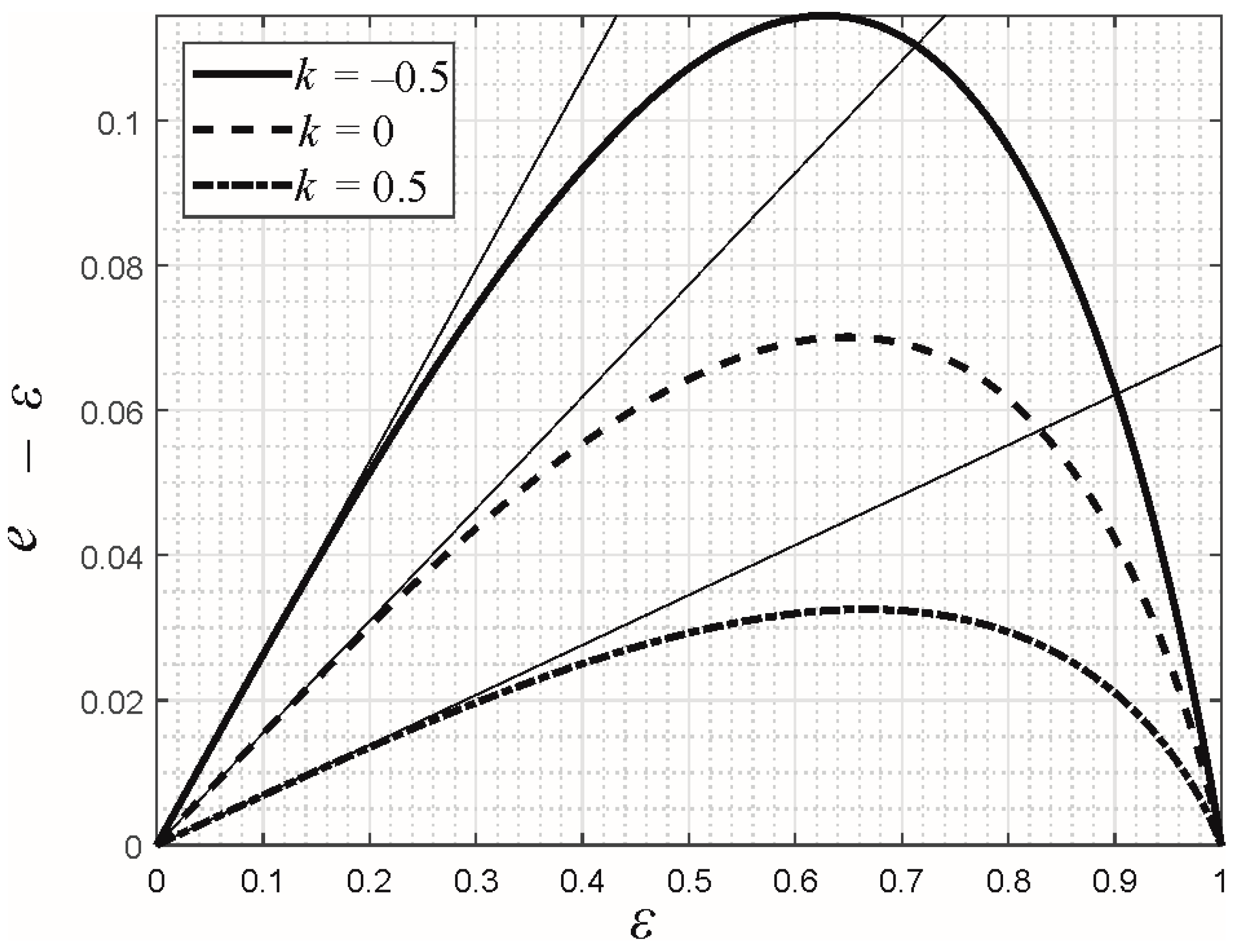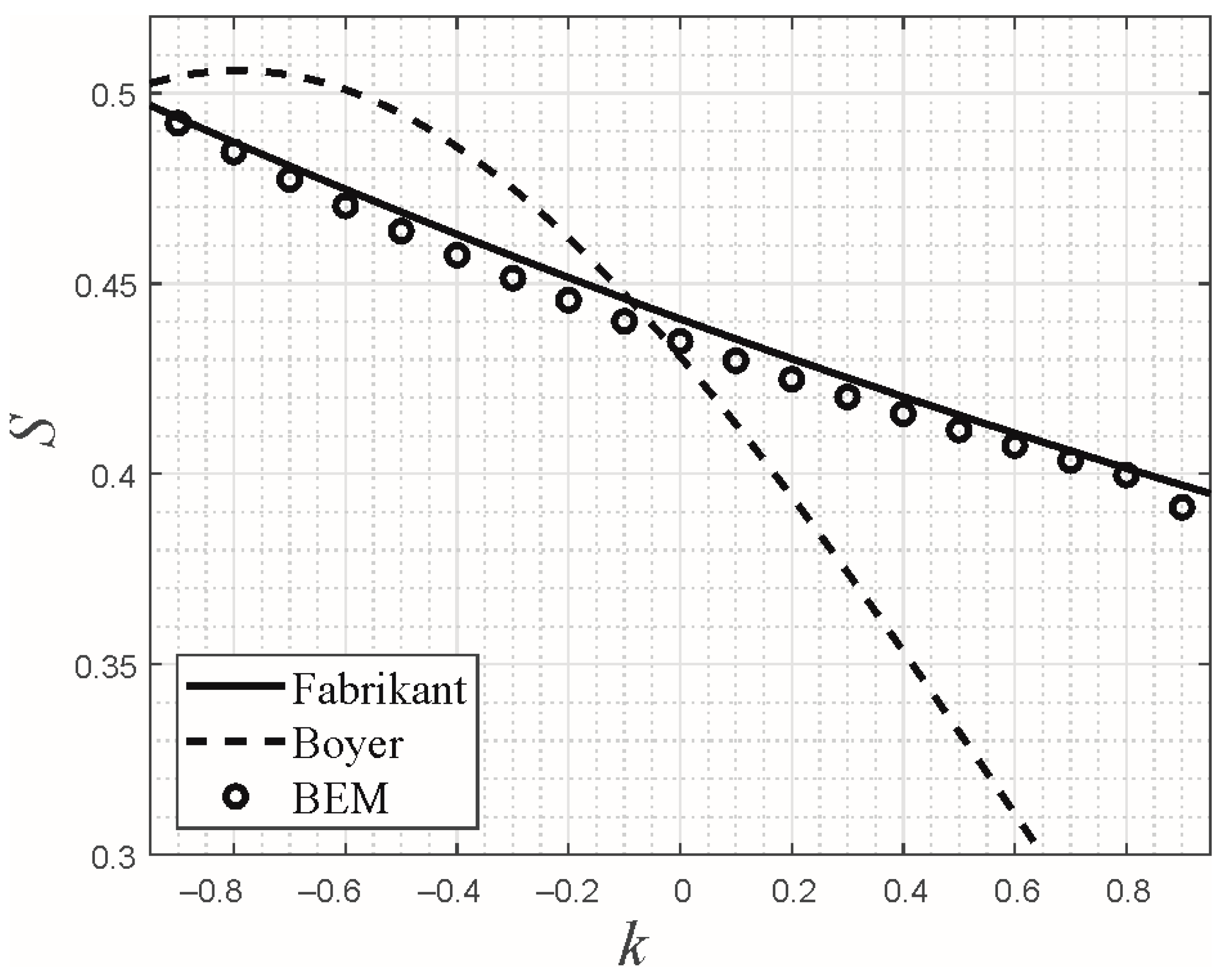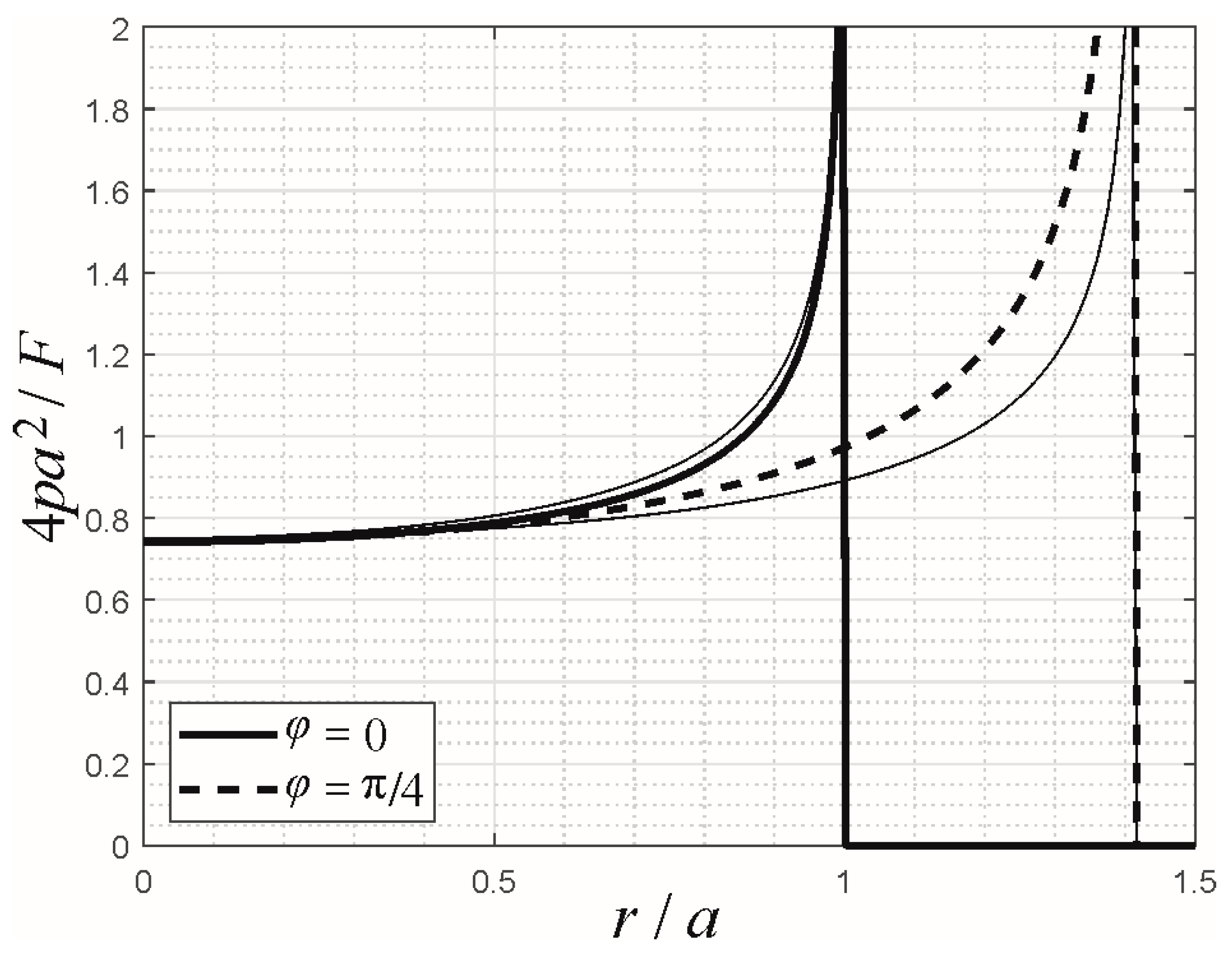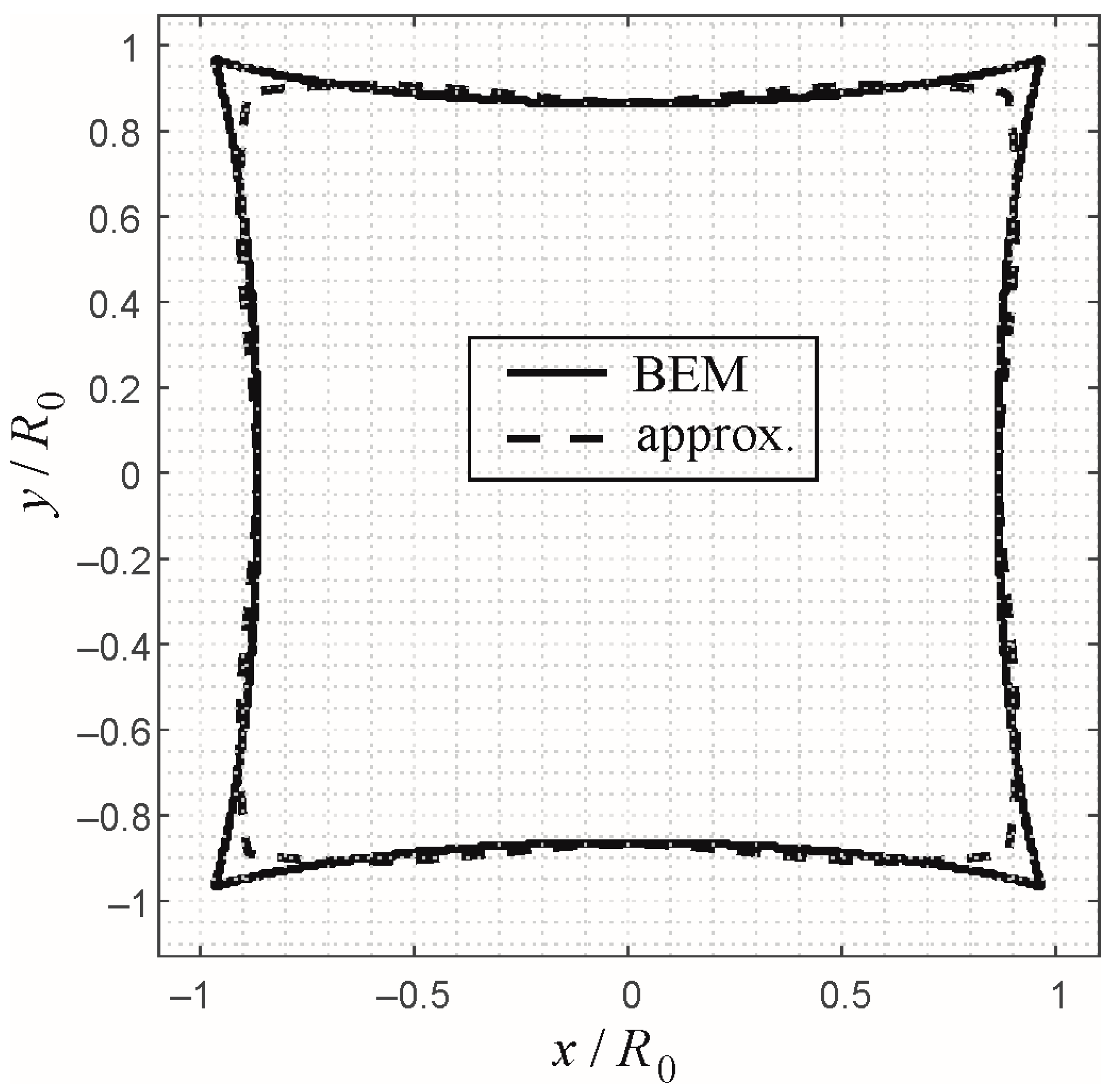On Boussinesq’s Problem for a Power-Law Graded Elastic Half-Space on Elliptical and General Contact Domains
Abstract
:1. Introduction
2. Fundamentals
2.1. Problem Formulation
2.2. Fundamental Solution for Point Loading
2.3. Generalization of Galin’s Theorem
2.4. Generalization of Barber’s Extremal Normal Force Principle
2.5. Elliptical Flat Punch
3. Contact with a Power-Law Ellipsoidal Indenter
3.1. Macroscopic Contact Solution
3.2. Pressure Distribution
3.3. Example: Elliptical Hertzian Contact
4. A Fabrikant-Type Approximation for General Contact Domains
Example: Flat Punch with Square Planform
5. General Approximate Solution for Almost Axisymmetric Contacts
5.1. General Approximate Solution Procedure for Non-Symmetric Profiles
5.2. Closed-Form Approximate Solution for Almost Axisymmetric Profiles
5.3. Pressure Distribution for Almost Axisymmetric Profiles
5.4. Example I: Elliptical Hertzian Contact
5.5. Example II: Indentation by a Pyramid with Square Planform
6. Discussion and Conclusions
Funding
Institutional Review Board Statement
Informed Consent Statement
Data Availability Statement
Acknowledgments
Conflicts of Interest
References
- Liu, Z.; Meyers, M.A.; Zhang, Z.; Ritchie, R.O. Functional gradients and heterogeneities in biological materials: Design principles, functions, and bioinspired applications. Prog. Mater. Sci. 2017, 88, 467–498. [Google Scholar] [CrossRef]
- Pompe, W.; Worch, H.; Epple, M.; Friess, W.; Gelinsky, M.; Greil, P.; Hempel, U.; Scharnweber, D.; Schulte, K. Functionally graded materials for biomedical applications. Mater. Sci. Eng. A 2003, 362, 40–60. [Google Scholar] [CrossRef]
- Li, X.; Lu, L.; Li, J.; Zhang, X.; Gao, H. Mechanical properties and deformation mechanisms of gradient nanostructured metals and alloys. Nat. Rev. Mater. 2020, 5, 706–723. [Google Scholar] [CrossRef]
- Suresh, S. Graded materials for resistance to contact deformation and damage. Science 2001, 292, 2447–2451. [Google Scholar] [CrossRef] [Green Version]
- Holl, D.L. Stress transmission in earths. Highw. Res. Board Proc. 1941, 20, 709–721. [Google Scholar]
- Jitcharoen, J.; Padture, P.N.; Giannakopoulos, A.E.; Suresh, S. Hertzian-Crack Suppression in Ceramics with Elastic-Modulus-Graded Surfaces. J. Am. Ceram. Soc. 1998, 81, 2301–2308. [Google Scholar] [CrossRef]
- Popov, V.L.; Heß, M.; Willert, E. Handbook of Contact Mechanics—Exact Solutions of Axisymmetric Contact Problems; Springer: Berlin/Heidelberg, Germany, 2019; 347p. [Google Scholar] [CrossRef] [Green Version]
- Cheng, Z.; Zhou, H.; Lu, Q.; Gao, H.; Lu, L. Extra strengthening and work hardening in gradient nanotwinned metals. Science 2018, 362, eaau1925. [Google Scholar] [CrossRef] [PubMed] [Green Version]
- Zhang, C.; Chen, F.; Huang, Z.; Jia, M.; Chen, G.; Ye, Y.; Lin, Y.; Liu, W.; Chen, B.; Shen, Q.; et al. Additive manufacturing of functionally graded materials: A review. Mater. Sci. Eng. A 2019, 764, 138209. [Google Scholar] [CrossRef]
- Kiarasi, F. Free vibration analysis of FG porous joined truncated conical-cylindrical shell reinforced by graphene platelets. Adv. Nano Res. 2021, 11, 361–380. [Google Scholar] [CrossRef]
- Selvadurai, A.P. The Analytical Method in Geomechanics. Appl. Mech. Rev. 2017, 60, 87–106. [Google Scholar] [CrossRef]
- Giannakopoulos, A.E.; Suresh, S. Indentation of Solids with Gradients in Elastic Properties: Part II. Axisymmetric Indentors. Int. J. Solids Struct. 1997, 34, 2393–2428. [Google Scholar] [CrossRef]
- Jin, F.; Guo, X.; Zhang, W. A Unified Treatment of Axisymmetric Adhesive Contact on a Power-Law Graded Elastic Half-Space. J. Appl. Mech. 2013, 80, 061024. [Google Scholar] [CrossRef]
- Heß, M. A simple method for solving adhesive and non-adhesive axisymmetric contact problems of elastically graded materials. Int. J. Eng. Sci. 2016, 104, 20–33. [Google Scholar] [CrossRef]
- Chen, S.; Yan, C.; Zhang, P.; Gao, H. Mechanics of adhesive contact on a power-law graded elastic half-space. J. Mech. Phys. Solids 2009, 57, 1437–1448. [Google Scholar] [CrossRef] [Green Version]
- Willert, E. Dugdale-Maugis Adhesive Normal Contact of Axisymmetric Power-Law Graded Elastic Bodies. Facta Univ. Ser. Mech. Eng. 2018, 16, 9–18. [Google Scholar] [CrossRef] [Green Version]
- Jin, F.; Tang, Q.; Guo, X.; Gao, H. A generalized Maugis-Dugdale solution for adhesion of power-law graded elastic materials. J. Mech. Phys. Solids 2021, 154, 104509. [Google Scholar] [CrossRef]
- Heß, M.; Popov, V.L. Method of Dimensionality Reduction in Contact Mechanics and Friction: A User’s Handbook. II. Power-Law Graded Materials. Facta Univ. Ser. Mech. Eng. 2016, 14, 251–268. [Google Scholar] [CrossRef] [Green Version]
- Heß, M.; Li, Q. Tangential contacts of three-dimensional power-law graded elastic solids: A general theory and application to partial slip. arXiv 2022, arXiv:2207.13166. [Google Scholar] [CrossRef]
- Rostovtsev, N.A. An integral equation encountered in the problem of a rigid foundation bearing on nonhomogeneous soil. PMM J. Appl. Math. Mech. 1961, 25, 238–246. [Google Scholar] [CrossRef]
- Rostovtsev, N.A. On certain solutions of an integral equation of the theory of a linearly deformable foundation. PMM J. Appl. Math. Mech 1964, 28, 127–145. [Google Scholar] [CrossRef]
- Galin, L.A. Contact Problems—The Legacy of L.A. Galin; Gladwell, G.M.L., Ed.; Springer: Dordrecht, The Netherlands, 2008; 318p. [Google Scholar] [CrossRef]
- Argatov, I.I. Asymptotic models of contact interaction among elliptic punches on a semiclassical foundation. Int. Appl. Mech. 2006, 42, 67–83. [Google Scholar] [CrossRef]
- Fabrikant, V.I. Flat punch of arbitrary shape on an elastic half-space. Int. J. Eng. Sci. 1986, 24, 1731–1740. [Google Scholar] [CrossRef]
- Popov, V.L. An Approximate Solution for the Contact Problem of Profiles Slightly Deviating from Axial Symmetry. Symmetry 2022, 14, 390. [Google Scholar] [CrossRef]
- Antipov, Y.A.; Mkhitaryan, S.M. Axisymmetric contact of two different power-law graded elastic bodies and an integral equation with two Weber–Schafheitlin kernels. Q. J. Mech. Appl. Math. 2022, 75, 393–420. [Google Scholar] [CrossRef]
- Rostovtsev, N.A. On the theory of elasticity of a nonhomogeneous medium. PMM J. Appl. Math. Mech. 1964, 28, 745–757. [Google Scholar] [CrossRef]
- Barber, J.R. Determining the contact area in elastic-indentation problems. J. Strain Anal. Eng. Des. 1974, 9, 230–232. [Google Scholar] [CrossRef] [Green Version]
- Barber, J.R. Contact Mechanics; Springer International Publishing AG: Cham, Switzerland, 2018; 585p. [Google Scholar] [CrossRef]
- Mossakovskii, V.I. Compression of Elastic Bodies under Conditions of Adhesion (Axisymmetric Case). PMM J. Appl. Math. Mech. 1963, 27, 630–643. [Google Scholar] [CrossRef]
- Willert, E. Analytic contact solutions of the Boussinesq and Cattaneo problems for an ellipsoidal power-law indenter. Meccanica 2023, 58, 109–117. [Google Scholar] [CrossRef]
- Shtayerman, I.Y. Contact Problem of the Theory of Elasticity. Edited Machine Translation of Kontaktnaya Zadacha Teorii Uprugostii, Gostekhizdat, Moskva (1949); Foreign Technology Division, WP-AFB: Dayton, OH, USA, 1970. [Google Scholar]
- Argatov, I.I. On the Sevostianov–Kachanov approximation for the incremental compliances of non-elliptical contacts. Math. Mech. Solids 2022. [Google Scholar] [CrossRef]
- Golikova, S.S.; Mossakovskii, V.I. Pressure of a plane stamp of nearly circular cross section on an elastic half-space. PMM J. Appl. Math. Mech. 1976, 40, 1085–1088. [Google Scholar] [CrossRef]
- Boyer, L. Contact resistance calculations: Generalizations of Greenwood’s formula including interface films. IEEE Trans. Compon. Packag. Manuf. 2001, 24, 50–58. [Google Scholar] [CrossRef]
- Li, Q.; Popov, V.L. Boundary element method for normal non-adhesive and adhesive contacts of power-law graded elastic materials. Comp. Mech. 2018, 61, 319–329. [Google Scholar] [CrossRef]
- Barber, J.R.; Billings, D.A. An approximate solution for the contact area and elastic compliance of a smooth punch of arbitrary shape. Int. J. Mech. Sci. 1990, 32, 991–997. [Google Scholar] [CrossRef] [Green Version]
- Khazanovich, L. The elastic-viscoelastic correspondence principle for non-homogeneous materials with time translation non-invariant properties. Int. J. Solids Struct. 2008, 45, 4739–4747. [Google Scholar] [CrossRef] [Green Version]
- Jäger, J. A New Principle in Contact Mechanics. J. Tribol. 1998, 120, 677–684. [Google Scholar] [CrossRef]
- Ciavarella, M. Tangential Loading of General Three-Dimensional Contacts. J. Appl. Mech. 1998, 65, 998–1003. [Google Scholar] [CrossRef] [Green Version]




Disclaimer/Publisher’s Note: The statements, opinions and data contained in all publications are solely those of the individual author(s) and contributor(s) and not of MDPI and/or the editor(s). MDPI and/or the editor(s) disclaim responsibility for any injury to people or property resulting from any ideas, methods, instructions or products referred to in the content. |
© 2023 by the author. Licensee MDPI, Basel, Switzerland. This article is an open access article distributed under the terms and conditions of the Creative Commons Attribution (CC BY) license (https://creativecommons.org/licenses/by/4.0/).
Share and Cite
Willert, E. On Boussinesq’s Problem for a Power-Law Graded Elastic Half-Space on Elliptical and General Contact Domains. Materials 2023, 16, 4364. https://doi.org/10.3390/ma16124364
Willert E. On Boussinesq’s Problem for a Power-Law Graded Elastic Half-Space on Elliptical and General Contact Domains. Materials. 2023; 16(12):4364. https://doi.org/10.3390/ma16124364
Chicago/Turabian StyleWillert, Emanuel. 2023. "On Boussinesq’s Problem for a Power-Law Graded Elastic Half-Space on Elliptical and General Contact Domains" Materials 16, no. 12: 4364. https://doi.org/10.3390/ma16124364
APA StyleWillert, E. (2023). On Boussinesq’s Problem for a Power-Law Graded Elastic Half-Space on Elliptical and General Contact Domains. Materials, 16(12), 4364. https://doi.org/10.3390/ma16124364





